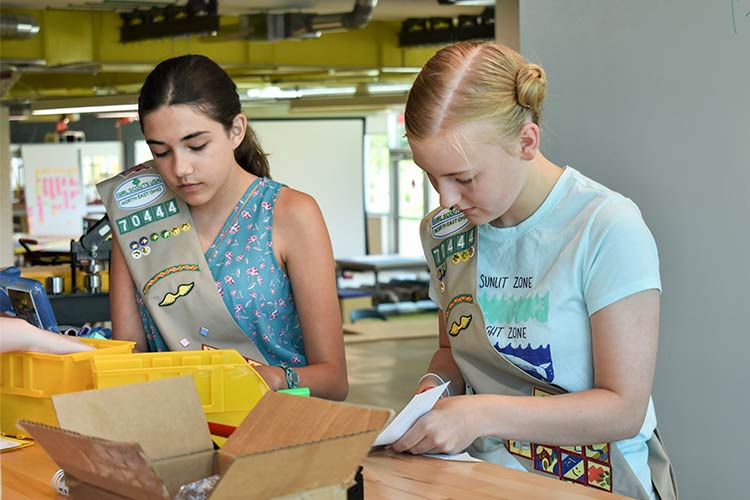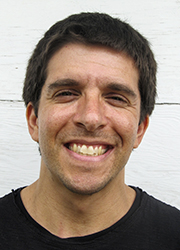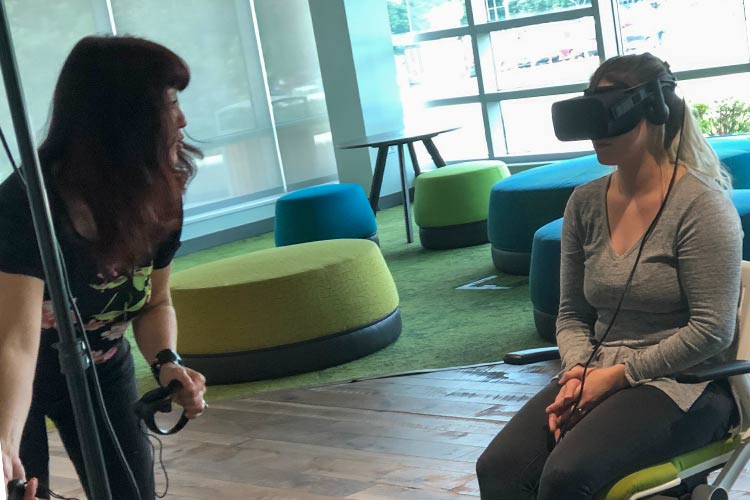
Meet your maker(s): Cleveland's makerspace scene continues to evolve
Meet the new wave of makerspaces, where communal workshops for tinkerers of all backgrounds foster ideas and turn dream projects into reality. Also known as hacker spaces or innovation labs, these enterprises are becoming entrenched in schools, libraries, and community centers, offering high-tech resources where the only limit is the user's imagination.
A hacker spaces wiki lists 1,400 active spaces worldwide, with more than 400 U.S. sites dedicated to hacking and making. While the usual suspects of California and New York lead the way, Ohio is no slouch—hosting the world’s largest makerspace in Columbus, as well as a growing ecosystem right here in Cleveland championing innovation and entrepreneurship.
 Cases in point: the brand-new Hive at Lakeland Community College, the still-under-construction Flux Makerspace at Cleveland Rocks Gym, and Case Western Reserve University's Larry Sears and Sally Zlotnick Sears think[box] (billed by the school as one of the world's largest university-based makerspaces). In late October, think[box] will open two new floors to meet demand and accommodate more entrepreneurs in bringing their ideas to fruition.
Cases in point: the brand-new Hive at Lakeland Community College, the still-under-construction Flux Makerspace at Cleveland Rocks Gym, and Case Western Reserve University's Larry Sears and Sally Zlotnick Sears think[box] (billed by the school as one of the world's largest university-based makerspaces). In late October, think[box] will open two new floors to meet demand and accommodate more entrepreneurs in bringing their ideas to fruition.
"Clevelanders are hungry for knowledge and opportunity, and it's at these makerspaces that they begin to gain traction," says Kevin Wojton of Flux Makerspace. "Right now, there are a few makerspaces in Cleveland, and their continued activities will help Cleveland grow into a major technology hub."
Out of the [box]
A seven-floor, 50,000 square-foot behemoth, think[box] welcomes CWRU students, faculty, alumni, and community members to further their personal projects or entrepreneurial pursuits. The space currently gets about 6,000 visits monthly, some of them repeat users, according to Tiffany McNamara, Senior Director for Strategic Partnerships and Business Development.
 The maker playground is located in the Richey Mixon Building, a former cold storage warehouse at 11201 Cedar Avenue—having outgrown its previous 4,500-square-foot space in the basement of CWRU's engineering center. Currently, the space utilizes five of the seven floors, with the final two floors set to open in late October.
The maker playground is located in the Richey Mixon Building, a former cold storage warehouse at 11201 Cedar Avenue—having outgrown its previous 4,500-square-foot space in the basement of CWRU's engineering center. Currently, the space utilizes five of the seven floors, with the final two floors set to open in late October.
"We started in a small space where we were bootstrapping with a piece of equipment in a corner, then it snowballed," says McNamara. "The challenge for an urban institution is feeling you're not accessible to those not attending. Getting people access to equipment is key for them to come in and collaborate."
Each floor plays a different role in empowering would-be makers regardless of academic or workforce discipline. For example, the first floor serves as a welcome area where ideas are shared and built upon. In the third-floor prototyping space, laser cutters, 3D printers, embroidery machines, and traditional manufacturing equipment (such as mills and sanders) breathe life into concepts devised on the lower floors.
 think[box]'s upper two levels offer space for innovators to scale ideas into startups, with experts providing guidance to help them meet market needs. In late October, the space’s final two floors will open, expanding upon those existing entrepreneurship and startup incubation services.
think[box]'s upper two levels offer space for innovators to scale ideas into startups, with experts providing guidance to help them meet market needs. In late October, the space’s final two floors will open, expanding upon those existing entrepreneurship and startup incubation services.
In the meantime, think[box] has produced numerous prototypes, from a portable steel forge to a robot caregiver for people in assisted living conditions. Cleveland Institute of Art alumnus Nolan Beck carved unique designs into side tables and other furniture using a router woodworking tool. think[box] also has a "pizza ATM," a Bon Appetit Management Co. mindchild that cooks the pizza internally, then delivers the goods through a slot at the machine's front.
Although most of the facility's current startups are student-based, think[box] officials expect to attract a diverse group of creators once more space is available.
"We want to have 25 founders when those floors open up," says McNamara. "Running out of room because there's so many successful startups is a problem we'd love to have."
Any idea, any time
Empathy is the creative focus at Hive, a makerspace at Lakeland Community College that officially opened in August following a soft launch at the beginning of 2018.Collaborating with the San Francisco global design firm IDEO, Hive's human-centered design approach means understanding and responding to the desires of the larger Lakeland community. Identifying human needs ideally leads to inspired project design, whether a Hive visitor is on their first or tenth attempt.
 "We're helping people develop confidence—not just in using equipment, but in understanding that failure is okay," says Hive director Dione DeMitro. "We encourage people to experiment, and failure is something that's embraced."
"We're helping people develop confidence—not just in using equipment, but in understanding that failure is okay," says Hive director Dione DeMitro. "We encourage people to experiment, and failure is something that's embraced."
Headquartered on the ground floor of the new Health and Innovation Building on Lakeland's Kirtland campus, Hive taps into the creativity of both students and citizens, who harness on-site technology to test ideas. Aiding this endeavor is the usual lineup of makerspace tools, including 3D printers, laser cutters, and augmented reality (AR) headsets.
 Basic woodshop and sewing accoutrements are used for jewelry, textiles, and additional crafting projects. Putting the "human" in human-centered design, Hive makes fleece blankets for children in need, and crochets old grocery bags into waterproof sleeping mats for homeless veterans.
Basic woodshop and sewing accoutrements are used for jewelry, textiles, and additional crafting projects. Putting the "human" in human-centered design, Hive makes fleece blankets for children in need, and crochets old grocery bags into waterproof sleeping mats for homeless veterans.
Staff-helmed workshops give participants a baseline competency on equipment, a low barrier of entry meant to hearten rather than discourage, notes DeMitro. Last fall, Hive ran two classes for a student-run anime and pop culture convention, walking young designers through the paces of costume creation and 3D-printed accessories.
"People have an idea in their head, and we want them to have immediate access (to equipment)," says DeMitro. "Some may get interested in 3D printing or advanced manufacturing, while others just want to relax and do something fun."
 A smaller yet still powerful catalyst for innovation is housed in Cleveland Public Library's TechCentral department, located in the lower level of the Louis Stokes Wing. Among the center's services are a 500-square-foot makerspace focusing on fabrication technology, along with photography, videography, and music production.
A smaller yet still powerful catalyst for innovation is housed in Cleveland Public Library's TechCentral department, located in the lower level of the Louis Stokes Wing. Among the center's services are a 500-square-foot makerspace focusing on fabrication technology, along with photography, videography, and music production.
Launched in 2014, the space highlights the library's role in informing and motivating an education-seeking public, says manager CJ Lynce. "Cleveland has a fabrication history—we want visitors to learn to create for themselves," Lynce says.
About half of TechCentral's makerspace patrons are novice users, while the other half are experienced makers representing a variety of fields. Youthful entrepreneurs press T-shirts, while architects 3D-print new designs and retired engineers transfer their advanced manufacturing skills into a new hobby. One industrious visitor made multi-sided gaming dice using an on-site laser engraver and 3D printer.
"We're not limiting what people want to do," says Lynce. "It's a neat space enabling anyone to make the idea that fits them."
Just the beginning
Hive funding derives from foundation grants and an Ohio Department of Education program aimed at workforce development. The makerspace received additional dollars from a bond issue that also paid for construction of the larger health innovation facility, DeMitro says.
 An advisory committee comprised of faculty and business leaders is guiding Hive during its growth process. Officials are also taking feedback from the student and community stakeholders who engage with the center daily to study, finish a project, or simply hang out with like-minded peers.In 2019, Hive will increase its hours of access and bring on community members to act as "makers in residence" for new visitors.
An advisory committee comprised of faculty and business leaders is guiding Hive during its growth process. Officials are also taking feedback from the student and community stakeholders who engage with the center daily to study, finish a project, or simply hang out with like-minded peers.In 2019, Hive will increase its hours of access and bring on community members to act as "makers in residence" for new visitors.
"It's a great moment when you see someone make something they have ownership of," says DeMitro. "The most exciting thing about it is that we're just beginning. Six months from now we won't recognize this space."
CWRU has invested nearly $40 million into think[box], funding the center primarily through private donations and a $1 million grant from Ohio Third Frontier. Support keeps the space open to an imaginative maker base eager to learn graphic design or 3D printing, then pay that knowledge forward in a friendly workshop environment.
"People here are doing awe-inspiring projects, whether they're students or someone trying to make money for a start-up," says McNamara, the outreach director. "I get to come to work every day and see what they can do when they have world-class machinery at their fingertips."


![3D Printing at Think[Box]](/galleries/Features/2018/Sept_2018/Issue_354/Cleveland_maker_spaces/think_box-2018_135.jpg)
![3D Printing at Think[Box]](/galleries/Features/2018/Sept_2018/Issue_354/Cleveland_maker_spaces/think_box-2018_126.jpg)
![Robotics dept at Think[Box]](/galleries/Features/2018/Sept_2018/Issue_354/Cleveland_maker_spaces/think_box-2018_217.jpg)
![Welding instruction at Think[Box]](/galleries/Features/2018/Sept_2018/Issue_354/Cleveland_maker_spaces/think_box-2018_058.jpg)
![Mechanical Manufacturing class at Think[Box]](/galleries/Features/2018/Sept_2018/Issue_354/Cleveland_maker_spaces/think_box-2018_105.jpg)
![Mechanical Manufacturing class at Think[Box]](/galleries/Features/2018/Sept_2018/Issue_354/Cleveland_maker_spaces/think_box-2018_027.jpg)
![Mechanical Manufacturing class at Think[Box]](/galleries/Features/2018/Sept_2018/Issue_354/Cleveland_maker_spaces/think_box-2018_049.jpg)
